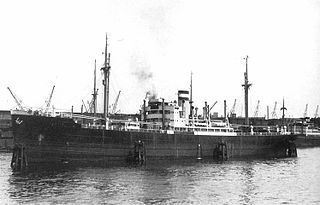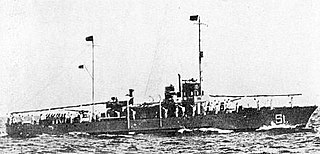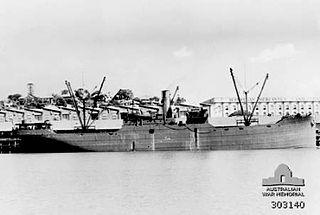
The United States' S-class submarines, often simply called S-boats, were the first class of submarines with a significant number built to United States Navy designs. They made up the bulk of the USN submarine service in the interwar years and could be found in every theater of operations. While not considered "Fleet Submarines" in the traditional sense of that term, they were the first submarines in the USN designed for open ocean, blue water operations. All previous submarines had been intended for harbor or coastal defense. These boats were intended to have greater speed and range than previous classes, with improved habitability and greater armament.
I-21 was a Japanese Type B1 submarine which saw service during World War II in the Imperial Japanese Navy. She displaced 1,950 tons and had a speed of 24 knots (44 km/h). I-21 was the most successful Japanese submarine to operate in Australian waters, participating in the attack on Sydney Harbour in 1942 and sinking 44,000 tons of Allied shipping during her two deployments off the east coast of Australia.

German submarine U-625 was a Type VIIC U-boat of Nazi Germany's Kriegsmarine during World War II. The submarine was laid down on 28 July 1941 at the Blohm & Voss yard in Hamburg, launched on 15 April 1942, and commissioned on 4 June 1942 under the command of Oberleutnant zur See Hans Benker.

German submarine U-172 was a Type IXC U-boat of Nazi Germany's Kriegsmarine during World War II. She was first assigned to the 4th U-boat Flotilla for training and on 1 May 1942 was reassigned to the 10th flotilla, an operational long-range organization.

The Taiyō-class escort carrier was a group of three escort carriers used by the Imperial Japanese Navy (IJN) during World War II. Two of the ships were built as cargo liners in the late 1930s and subsequently taken over by the IJN and converted into escort carriers, while the third ship was converted while still under construction. The first ship converted, Taiyō, ferried aircraft and supplies to Japanese possessions before the start of the Pacific War in December 1941 and also served as a training ship between transport missions. Once the war began she did much the same for the newly conquered areas. Her sister ship, Un'yō did much the same in 1942. Chuyō, the last of the three to be converted, only ferried aircraft between Japan and the naval base at Truk before she was sunk by an American submarine in December 1943. Her sisters sometimes had other destinations other than Truk in 1943, but it was also their primary destination until they were damaged by American submarines in late 1943 or early 1944. After finishing their repairs in 1944, the sisters combined convoy escort duties with their transport missions and often ventured as far south as Singapore. Taiyō was the first of the pair to be sunk, torpedoed by an American submarine in August, with Un'yō following her sister a month later.

Arisan Maru was a 6,886 GRT Type 2A freighter constructed in 1944 during World War II and was one of Imperial Japan's hell ships. The vessel, named for a mountain on Formosa, was initially used as a troop transport. The vessel was then turned over for use for the transportation of prisoners of war (POWs) from the Philippines to Manchuria, China or Japan. On October 24, 1944 the ship was torpedoed by an American submarine and sank. Of the 1,781 POWs aboard, all of them escaped the sinking ship but were not rescued by the Japanese. In the end, only nine of the prisoners survived the sinking.

MSPalatia was a German cargo liner, built in 1928. After serving for several years on the Hamburg America Line's route to the Caribbean, she was sold to the Soviet Union in 1940. Following the outbreak of war between Nazi Germany and the Soviet Union in June 1941, she was captured by the Germans and pressed into Kriegsmarine service.
German submarine U-92 was a Type VIIC U-boat of Nazi Germany's Kriegsmarine during World War II.

Aikoku Maru (愛国丸) was an armed merchant cruiser of the Imperial Japanese Navy in World War II. The ship entered service in 1940, the ship was later converted to an ammunition ship. She was sunk in February 1944 during Operation Hailstone.

I-65, later renumbered I-165, was an Imperial Japanese Navy Kaidai type cruiser submarine commissioned in 1932. A KD5 sub-class submarine, she served during World War II, supporting Japanese forces in the invasion of Malaya and the Dutch East Indies campaign, participating in the Battle of Midway, and patrolling in the Indian Ocean and Pacific Ocean before she was sunk in 1945. In 1944, her crew committed a war crime, massacring the survivors of the merchant ship Nancy Moller.
SS Nicholas Cuneo was a Honduran Cargo ship that was shelled and sunk by U-571, 47 nautical miles (87 km) North of Havana in the Gulf of Mexico, while travelling from New Orleans, United States to Havana, Cuba.

The Battle of Cape Burnas was a naval engagement between the Soviet and Romanian navies near the Burnas Lagoon in October 1942.
SS Sulina was a Romanian cargo ship that was torpedoed by the Soviet submarine A-3 and sank on 29 May 1942 near Odessa while carrying general cargo.
SS Argo was a Finnish Cargo ship that the Soviet submarine Shch-317 torpedoed on 16 June 1942 in the Gulf of Finland between Bogskär and Utö, Finland.

SS Managua was a Nicaraguan cargo ship that the German submarine U-67 torpedoed on 16 June 1942 in the Straits of Florida while she was travelling from Charleston, South Carolina, United States to Havana, Cuba with a cargo of potash. The ship was built as Glorieta, a Design 1049 ship in 1919, operated by the United States Shipping Board (USSB) until sold to the Munson Steamship Line in 1920 and renamed Munisla. The ship was sold foreign to a Honduran company, Garcia, in 1937 and renamed Neptuno. In 1941 the ship was re-flagged in Nicaragua with the name Managua.
SS Rio Tercero was an Argentinian Cargo ship that the German submarine U-202 torpedoed on 22 June 1942 in the Atlantic Ocean 120 nautical miles (220 km) east of New York City while she was travelling from New York City to Buenos Aires, Argentina while carrying 3500 tons of general cargo including coal and mail.
SS Uniwaleco was a South-African Whale Factory ship that was torpedoed by the German submarine U-161 in the Caribbean Sea 45 nautical miles (83 km) west of the Saint Vincent Passage on 7 March 1942 while she was travelling from Curaçao to Freetown with a stopover in Trinidad while carrying a cargo of 8800 tons of fuel oil.
SS Equipoise was a Panamanian Cargo ship that was torpedoed by the German submarine U-160 in the Atlantic Ocean 60 nautical miles (110 km) south east of Cape Henry, Virginia, United States on 27 March 1942.
SS Santa Fé was a German refrigerated cargo steamship. She is now a Black Sea shipwreck and part of her cargo is of interest to marine archaeologists.

SS Coast Trader was built as the cargo ship SS Holyoke Bridge in 1920 by the Submarine Boat Company in Newark, New Jersey. The Coast Trader was torpedoed and sank 35 miles (56 km) south west of Cape Flattery, off the Strait of Juan de Fuca in U.S. state of Washington by the Japanese submarine I-26. Survivors were rescued by schooner Virginia I and HMCS Edmundston. She rests on the ocean floor at.










